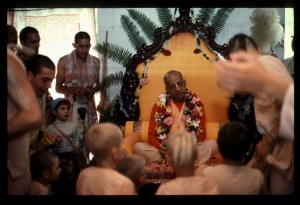SB 1.16.11 (1965)

A.C. Bhaktivedanta Swami Prabhupada
TEXT No. 11
Swalamkritam shyama turanga yojitam Ratham mrigendra dhwajam asritah purat. Vrito ratha aswa dwipapatti yuktaya Swasenaya digvijayaya nirgatah.
ENGLISH SYNONYMS
Salamkritam—very well decorated, Shyama—black, Turanga—horses, Yojitam—tackled, Ratha—Chariot, Mrigendra—lion, Dhwajam—flag-staffed, Asritah—under the protection, Purat—from the capital, Vrito—surrounded by, Ratha—charioteers, Aswa—cavalry, Dwipapatti—elephants, Yuktaya—thus being equipped, Swasenaya—along with infantry, Digvijayaya—for the purpose of conquering, Nirgatah—went out.
TRANSLATION
Maharaj Parikshit was seated on a chariot which was tackled with black horses, flag staffed with the sign of a lion and thus being well decorated he was surrounded by charioteers, cavalry, elephants and infantry soldiers he went out of the capital for conquering all directions.
PURPORT
Maharaj Parikshit is distinguished from his grand father Arjuna as he tackled black horses in his chariot instead of white horses of his grand father. He ensigned his flag staff with the mark of a lion than his grand father who ensigned the flag with mark of Hanumanji. A royal procession like that of Maharaj Parikshit surrounded by well decorated chariots, cavalry, elephants, infantry and band is not only pleasing to the eyes but also they were signs of aesthetic sense of a civilization used to be manifested even in the fighting front.